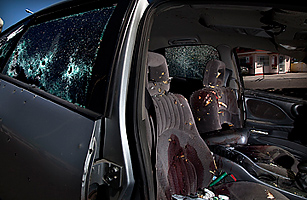
This is how Mexican investigators believe gangsters murdered business student Juan Francisco Sicilia: Two of his friends had been assaulted in Cuernavaca, south of Mexico City, by a pair of policemen moonlighting as muggers for the Pacfico Sur drug cartel. The friends reported the criminal cops, who panicked and asked their mafia bosses for help. On March 27, eight Pacfico Sur thugs, including a crazed psychopath called El Peln , abducted the two accusers, as well as Juan Francisco and four other buddies, from a bar. They were bound with packing tape, tortured in a safe house and suffocated to death. Their bodies were found the next day outside the city.
Both the cops and the killers likely expected the massacre to go unnoticed: in Mexico, gangland homicides have claimed nearly 40,000 lives in the past five years, up from less than 7,000 from 2001 to 2005. But Juan Francisco was not destined to be a statistic. He was the son of Javier Sicilia, one of the nation’s best-known authors and poets, who has turned the young man’s murder into a national movement of outrage over the unchecked violence of drug cartels, known as los narcos, and the government’s inability to put an end to their reign of terror.
With the rallying cry “Estamos hasta la madre!” , Sicilia has helped organize large protest marches in Cuernavaca, Mexico City and more than 30 other towns. In June he led a bus caravan to the border city of Jurez, where 3,200 were killed last year — a murder rate of more than 200 per 100,000 residents, which makes it the most dangerous city not just in Mexico but the world — and where hundreds of families met Sicilia holding pictures of slain relatives.
Sicilia has at least achieved some poignant literary symbolism. In one of Mexico’s most celebrated novels, Pedro Pramo by Juan Rulfo, the victims of murder clamor for rule of law in their lawless land, and the poet hears those voices now. “We’re finally articulating names for the drug war’s dead,” Sicilia tells me. “We’re letting their voices rise above ours and be more than just numbers and abstractions in this demoniacal tragedy.”
Mexico’s national horror story is often told as a gangster epic full of lurid detail of the lives and deaths of drug kingpins. Or it’s reduced to dry figures: the cartels make $30 billion a year, equal to the economy of a midsize Central American nation, moving marijuana, cocaine, heroin and methamphetamine into the U.S. At home they earn extra from activities like kidnapping, a crime that’s up 317% in Mexico since 2005. Protests led by a bereaved poet are giving the tragedy a human face, as are the heroic acts of civilians like teacher Martha Rivera, who in late May became an Internet star because of a YouTube video showing her calming her kindergarten class as hit men executed five people with assault rifles outside her school in the northern city of Monterrey.
For 22 years, I’ve covered the rise of Mexico’s drug gangs, charting their evolution from trafficking mules for Colombian cartels to the dominant players of the narcotics trade in the western hemisphere. They’ve morphed from mafiosi who once killed only one another — I remember the national trauma when a Roman Catholic cardinal was caught in their cross fire in 1993 — into monsters who routinely slaughter innocents. Last August, Los Zetas, a bloodthirsty gang led by former army commandos, executed 72 migrant workers on a ranch in northern Tamaulipas state just because they couldn’t pay the extortion money the gangsters demanded.
The violence is so pervasive, so constant, that only the most egregious episodes remain in the memory. Like last year’s massacre of 15 teenagers at a Jurez party by narcos who mistook them for rivals. Or the eight people killed in 2008, when thugs tossed grenades into a crowd celebrating Mexico’s independence day in western Michoacn, President Felipe Caldern’s home state. Or what happened in 2009 after Mexican marines killed drug lord Arturo Beltrn Leyva: his gunmen went to southern Tabasco state, to the funeral of a marine killed in the shoot-out, and gunned down the man’s mother and three relatives.
On June 23, Caldern started a formal dialogue with victims’ groups designed to lead to the kind of police, judicial and social reforms Mexico desperately needs. Inside Mexico City’s Chapltepec Castle, Sicilia and Caldern butted heads, but they know they are in this together. “I join your outcry,” said Caldern. “I’m willing to make changes.”
See photos inside Mexico’s drug tunnels.